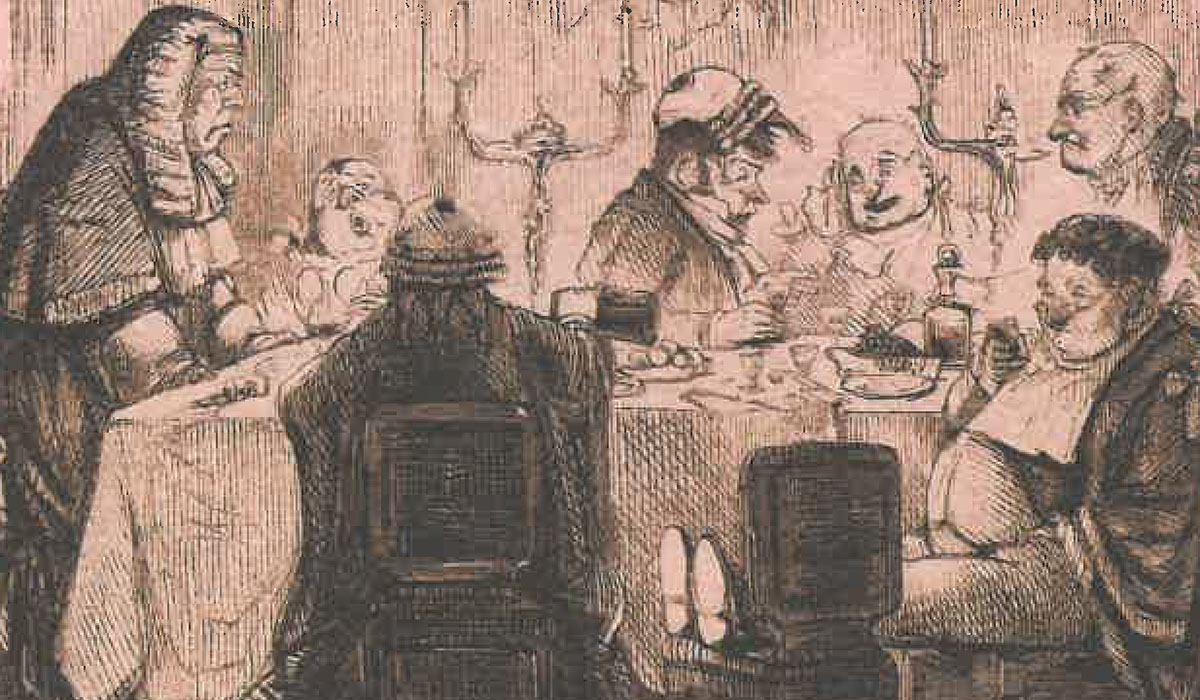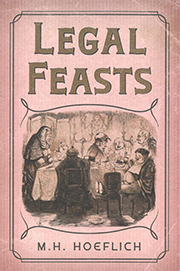'Legal Feasts' collects history, menus from legal dinners spanning more than a century

LAWRENCE — Say what you will about lawyers, they have to eat, too. And when they gather, they can be quite good at throwing a dinner.
Michael Hoeflich has seen his share of dinners, banquets, receptions and gatherings in his decades as a lawyer, professor of law and law school dean — and he has the menus to prove it. In his newest book, “Legal Feasts: Commensality and Conviviality in the Legal Profession,” Hoeflich shares menus and recipes from legal dinners spanning more than a century while offering his reflections on the central role communal dining has played in the history of the law.

Hoeflich, the John H. and John M. Kane Distinguished Professor of Law at the University of Kansas School of Law, has spent much of his career looking past the adversarial and confrontational aspects of the law. Previous works have documented the law in ephemera and a journal article examining the history of communal dinners. The latter work determined that a certain amount of dinners were required before young lawyers could officially join the bar in England.
Then the COVID-19 pandemic hit, and the article became a book.
“Like many people, I was looking for things I could do, and things that might be more entertaining than the average law book,” Hoeflich said. “In the 19th century, chapbooks were very common. I thought, ‘Wouldn’t it be fun to do a legal chapbook?’ The original article was about how getting together for a meal was a long-standing tradition in the bar. The whole idea of the dinners was to evince conviviality and networking. I also love food and was an administrator who went to a lot of dinners.”
Those intersecting interests eventually became “Legal Feasts.” The chapbook — a brief work or pamphlet often containing tales or poetry — was the ideal format for the work. It opens with Hoeflich’s examination of the long history of legal dinners and their central role in the profession. He then shares a section of menus from legal dinners dating back to the late 19th century.
The menus found their way to Hoeflich through various means. The first was stored away in a law book he picked up many years ago. Others were purchased online from other collectors. And some were from dinners Hoeflich attended, like the 1980 Cravath Annual Dinner Dance.
The 1890 Retirement Dinner by the Bar of Scotland for Lord Shand is featured alongside an illustrated menu featuring items with French names. Other menus include the 1911 Annual Dinner of the Rhode Island Bar Association, 1914 Women’s Lawyer Association Dinner, Kansas City School of Law 1929 Washington’s Birthday Banquet and the 1947 Dinner for Thomas Dewey by the Columbia Law School Alumni Association.
“You can learn a lot about various places from how they wrote their menus and what they served. That’s one of the things I enjoyed, seeing who was really trying to impress people,” Hoeflich said.
To that point, the Kansas City dinner featured dishes such as fruit cocktail and fried chicken, while the Columbia dinner menu mentioned Lobster and Crabmeat Louis and French desserts such as Glace Surprise and Petit Fours. The Women’s Lawyer Association menu dispensed with the cigars and cigarettes common to many other early gatherings, and the Cravath dinner opened with Petite Marmite Henri IV.
Hoeflich concludes “Legal Feasts” with a collection of recipes. Each was featured in a menu of a legal dinner, and recipes were often taken from cookbooks Hoeflich has collected over the years. Regardless of source, Hoeflich has prepared all of them in his own kitchen. The roast beef and horseradish sauce is presented in the method his grandmother made, complete with instructions on brining the beef and making the sauce, with the important reminder to be careful with the grated horseradish, as “it can be quite hot.” Turtle soup played a large role in legal menus, and the recipes are included, with the note that green turtle is protected in the United States and its consumption is illegal. But not to worry: A mock turtle soup recipe made with calf’s head is at the ready.
Other recipes include Thousand Island Dressing, egg mayonnaise and Chicken Mulligatawny, a recipe Hoeflich said he enjoyed in his days as a law student.
While the menus evolved with changing tastes, one thing has remained constant: the joy of dining with others.
“I don’t know of many things that are more central to the human experience than eating together,” Hoeflich said. “It’s part of humanity, and that’s really why I did this.”
As for the menus and elaborate illustrations documenting the banquets, dinners and receptions, they survived because they document a momentous occasion. For Hoeflich, the 1980 dinner at The Pierre Hotel in New York was his last while an associate at Cravath, Swaine & Moore. He remembers seeing the spouses of colleagues he’d never met enjoying fine food and drink and conversing with fellow lawyers away from the pressures of the office or courtroom days before beginning his academic career.
When he looks over menus from dinners long past, Hoeflich said he is reminded of reading Dickens and being able to picture Victorian London thanks to the evocative descriptions.
“To someone, that dinner had a lot of meaning. When I look at things like a menu that was never meant to be saved, I know it wasn’t an accident,” Hoeflich said. “It got saved because someone thought it was important and had significance beyond the immediate. I’ve spent most of my career trying to humanize the law and let people know that law is driven by people and can be fun.”